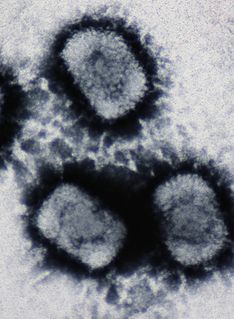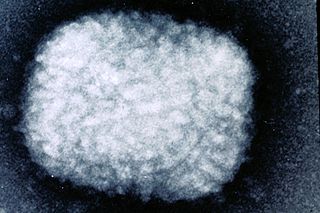| Look up variola in Wiktionary, the free dictionary. |
Variola is a Latin name for smallpox.
Variola may also refer to:
- Variola (fish), a genus of fish
| Look up variola in Wiktionary, the free dictionary. |
Variola is a Latin name for smallpox.
Variola may also refer to:
Variola caprina is a contagious viral disease caused by Goatpox virus, a pox virus that affects goats. The virus usually spreads via the respiratory system, and sometimes spreads through abraded skin. It is most likely to occur in crowded stock. Sources of the virus include cutaneous lesions, saliva, nasal secretions and faeces. There are two types of the disease: the papulo-vesicular form and the nodular form. The incubation period is usually 8–13 days, but it may be as short as four days.

Variola Vera is a 1982 Yugoslav film directed by Goran Marković. The subject of the film is the 1972 outbreak of smallpox in Yugoslavia, more specifically the events related to the epidemic and the subsequent quarantine at Belgrade's General Hospital. Although inspired by the real events, the movie features elements of horror.
| This disambiguation page lists articles associated with the title Variola. If an internal link led you here, you may wish to change the link to point directly to the intended article. |

Cowpox is an infectious disease caused by the cowpox virus. The virus, part of the genus Orthopoxvirus, is closely related to the vaccinia virus. The virus is zoonotic, meaning that it is transferable between species, such as from animal to human. The transferral of the disease was first observed in dairymaids who touched the udders of infected cows and consequently developed the signature pustules on their hands. Cowpox is more commonly found in animals other than bovines, such as rodents. Cowpox is similar to, but much milder than, the highly contagious and often deadly smallpox disease. Its close resemblance to the mild form of smallpox and the observation that dairy farmers were immune from smallpox inspired the first smallpox vaccine, created and administered by English physician Edward Jenner.

Vaccinia virus is a large, complex, enveloped virus belonging to the poxvirus family. It has a linear, double-stranded DNA genome approximately 190 kbp in length, and which encodes approximately 250 genes. The dimensions of the virion are roughly 360 × 270 × 250 nm, with a mass of approximately 5–10 fg.
Pox may refer to:

The 1972 Yugoslav smallpox outbreak was the last major outbreak of smallpox in Europe. It was centred in Kosovo and Belgrade. A Muslim pilgrim had contracted the smallpox virus in the Middle East. Upon returning to his home in Kosovo, he started the epidemic in which 175 people were infected, 35 of whom died. The epidemic was efficiently contained by enforced quarantine and mass vaccination. The 1982 film Variola Vera is based on the event.

Poxviridae is a family of viruses. Humans, vertebrates, and arthropods serve as natural hosts. There are currently 69 species in this family, divided among 28 genera, which are divided into two subfamilies. Diseases associated with this family include smallpox.
The 1978 smallpox outbreak in the United Kingdom resulted in the death of Janet Parker, a British medical photographer, who became the last recorded person to die from smallpox. Her illness and death, which was connected to the deaths of two other people, led to an official government inquiry and triggered radical changes in how dangerous pathogens were studied in the UK. The government inquiry into Parker's death by R.A. Shooter found that while working at the University of Birmingham Medical School, she was accidentally exposed to a strain of smallpox virus that had been grown in a research laboratory on the floor below her workplace, and that the virus had most likely spread from that laboratory through ducting. Shooter's conclusion on how the virus had spread was challenged in court when the University of Birmingham was unsuccessfully prosecuted by the Health and Safety Executive for breach of Health and Safety legislation.
The Institute of Virus Preparations was an agency of the former Soviet Union.
Orthopoxvirus is a genus of viruses in the family Poxviridae and subfamily Chordopoxvirinae. Vertebrates, including mammals and humans, and arthropods serve as natural hosts. Currently, 10 species are in this genus, including the type species Vaccinia virus. Diseases associated with this genus include smallpox, cowpox, horsepox, and monkeypox. The most infamous member of the genus is Variola virus, which causes smallpox. It was eradicated using Vaccinia virus as a vaccine.
Artificial induction of immunity is the artificial induction of immunity to specific diseases – making people immune to disease by means other than waiting for them to catch the disease. The purpose is to reduce the risk of death and suffering.
Camelpox is a disease of camels caused by a virus of the family Poxviridae, subfamily Chordopoxvirinae, and the genus Orthopoxvirus. It causes skin lesions and a generalized infection. Approximately 25% of young camels that become infected will die from the disease, while infection in older camels is generally more mild. Although rare, the infection may spread to the hands of those that work closely with camels.

Ali Maow Maalin was a Somali hospital cook and health worker from Merca who is the last person known to be infected with naturally occurring Variola minor smallpox. He was diagnosed with the disease in October 1977 and made a full recovery. Although he had many contacts, none of them developed the disease and an aggressive containment campaign was successful in preventing an outbreak. Smallpox was declared to have been eradicated globally by the World Health Organization (WHO) two years later. Maalin was subsequently involved in the successful poliomyelitis eradication campaign in Somalia, and he died of malaria while carrying out polio vaccinations after the re-emergence of the poliovirus in 2013.

Smallpox was an infectious disease caused by one of two virus variants, Variola major and Variola minor. The last naturally occurring case was diagnosed in October 1977 and the World Health Organization (WHO) certified the global eradication of the disease in 1980. The risk of death following contracting the disease was about 30%, with higher rates among babies. Often those who survived had extensive scarring of their skin and some were left blind.
Geoffrey Lilley Smith FRS FMedSci FRSB is a British virologist and medical research authority in the area of Vaccinia virus and the family of Poxviruses. Since 1 October 2011 he is Head of the Department of Pathology at the University of Cambridge and a Principal Research Fellow of the Wellcome Trust. Before that, he was Head of the Department of Virology at Imperial College London.
Alastrim, also known as variola minor, was the milder strain of Variola virus that caused smallpox. The last known case of variola minor was in Somalia, Africa in 1977. Smallpox was formally declared eradicated on May 8, 1980.
The Chordopoxvirinae are a subfamily of viruses in the family Poxviridae. Humans, vertebrates, and arthropods serve as natural hosts. Currently, 38 species are placed in this subfamily, divided among 10 genera. Diseases associated with this subfamily include smallpox.

Monkeypox virus (MPV) is a double-stranded DNA, zoonotic virus and a species of the genus Orthopoxvirus in the family Poxviridae. It is one of the human orthopoxviruses that includes variola (VARV), cowpox (CPX), and vaccinia (VACV) viruses. But it is not a direct ancestor to, nor a direct descendent of, the variola virus which causes smallpox. The monkeypox virus causes a disease that is similar to smallpox, but with a milder rash and lower death rate. Variation in virulence of the virus has been observed in isolates from Central Africa where strains are more virulent than those from Western Africa.
The smallpox virus retention debate has been ongoing among international scientists and other officials since smallpox was declared eradicated by the World Health Organization (WHO) in 1980. It centers on whether to finally and irreversibly destroy the two last remnants of the virus that causes smallpox, which reside in government laboratories in the United States and Russia. Advocates of final destruction maintain that there is no longer any valid rationale for retaining the samples, which represent a hazard, while opponents of it maintain that the samples are needed for further research as smallpox virus may still exist in the world outside of the two labs, and thus may re-emerge, particularly as a bio-weapon.
The terms inoculation, vaccination, and immunization are often used synonymously to refer to artificial induction of immunity against various infectious diseases. However, there are some important historical and current differences. In English medicine, inoculation referred only to the practice of variolation until the very early 1800s. When Edward Jenner introduced smallpox vaccine in 1798, this was initially called cowpox inoculation or vaccine inoculation. Soon, to avoid confusion, smallpox inoculation continued to be referred to as variolation and cowpox inoculation was referred to as vaccination. Then, in 1891, Louis Pasteur proposed that the terms vaccine and vaccination should be extended to include the new protective procedures being developed. Immunization refers to the use of all vaccines but also extends to the use of antitoxin, which contains preformed antibody such as to diphtheria or tetanus exotoxins. Inoculation is now more or less synonymous in nontechnical usage with injection and the like, and questions along the lines of "Have you had your flu injection/vaccination/inoculation/immunization?" should not cause confusion. The focus is on what is being given and why, not the literal meaning of the technique used.
Rijk Gispen, was a Dutch virologist and former Director of the National Institute of Public Health in the Netherlands. He is well known for his research in immunology and the study of orthopoxviruses.